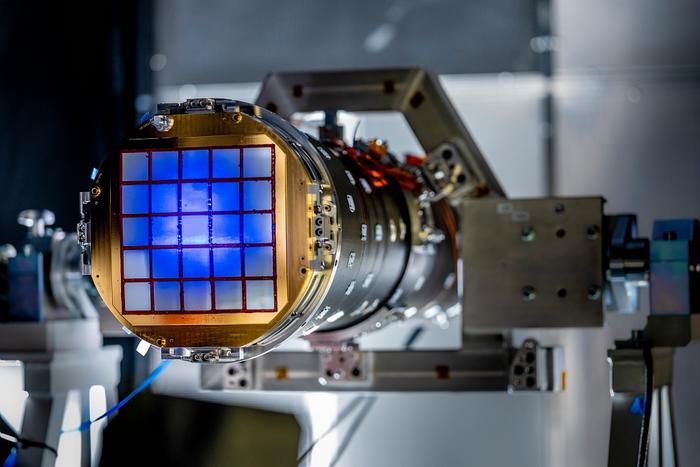A satellite telescope designed to rapidly hunt down the universe’s biggest explosions will launch later this week, carrying technology developed at the University of Leicester.

Credit: © CNES/DE PRADA Thierry, 2021
A satellite telescope designed to rapidly hunt down the universe’s biggest explosions will launch later this week, carrying technology developed at the University of Leicester.
The Space Variable Objects Monitor (SVOM) is the second mission this year to benefit from expertise in X-ray optics at Leicester, following the launch of Einstein Probe in January.
The SVOM mission (Space-based multi-band astronomical Variable Objects Monitor) is a Franco-Chinese mission dedicated to the study of the most distant explosions of stars, the gamma-ray bursts, due to be launched on 22 June 2024 from the Xichang launch base.
It is the result of a collaboration between the two national space agencies, CNSA (China National Space Administration) and CNES (Centre national d’études spatiales), with the main contributions of the Institute of Research into the Fundamental Laws of the Universe (Irfu) and the Research Institute of Astrophysics and Planetology (IRAP) for France and the National Astronomical Observatory (NAO) and the Beijing High Energy Institute (IHEP) for China.
The team at the University of Leicester built and tested the optics for the X-ray telescope on SVOM, called the microchannel X-ray telescope (MXT). It is the latest mission they have contributed their substantial experience of building optics to, which has also been used on ESA/JAXA’s BepiColombo mission. They will also be part of the science team for the mission, boosting their research into high-energy physics across the universe.
Professor Paul O’Brien from the University of Leicester School of Physics and Astronomy led the Leicester team. He said: “For the areas we particularly want to study, we want to take advantage of SVOM flying alongside the NASA/UK/Italy Neil Gehrels Swift observatory and the NASA/ESA James Webb Space Telescope, to study distant gamma ray bursts, the early universe and gravitational waves.
“We want a larger field of view X-ray telescope because we’re interested in a brand-new area of science: looking for the sources of gravitational waves. Gravitational wave detectors don’t give us a very good location accuracy on the sky and we need to search that area quickly, so the X-ray telescope built for SVOM is designed to do that.”
For the MXT the team used micropore optics, similar those on the BepiColombo mission, which allow a wider field-of-view instrument and are also extremely light, allowing SVOM to carry more instrumentation than its predecessor, Swift.
Dr Charly Feldman from the School of Physics and Astronomy said: “The optics on the MXT instrument are very special. They are called a lobster-eye optic, which is where we have smaller individual X-ray optics tessellated onto a curved frame and then they work together to create a larger field of view.
“They are based on the eyes of crustaceans such as lobsters and crayfish which, because they live in very deep dark waters, have to be able to collect as many photons as possible. They do that by having lots of individual pores across their eye in a spherical formation, focused on a spherical retina. We replicate this by creating 40-micron tubes, very similar to optical fibres, which are stacked and then slumped so that all the pores are pointing to a single focus.”
Dr Rob Eyles-Ferris from the School of Physics and Astronomy will be a ‘Burst Advocate’ on the SVOM mission, fulfilling a similar role he held on the Swift mission.
Dr Eyles-Ferris said: “When SVOM detects a gamma-ray burst, the Burst Advocate’s role is to co-ordinate the follow-up, keep track of all the data that SVOM takes, possibly from ground-based telescopes as well.
“SVOM’s going to see all kinds of new events and is ideal for detecting jetting TDEs – tidal disruption events, where the matter falling on to a black hole has arrived so quickly that the black hole can’t accrete it and it shoots material out at speeds close to the speed of light. There’s only been four of them observed so far. The ECLAIRS instrument on SVOM is ideal for detecting them, it’s the right kind of energy regime, and the MXT is ideal for keeping an eye on them. Their later behaviour is complicated and tells you a lot about both a black hole and the star it originally came from and how the event actually occurred. TDEs, and particularly jetted ones, are probes of extreme physics that you can’t really investigate any other way.”



